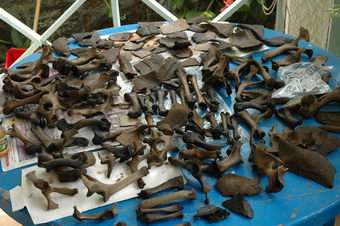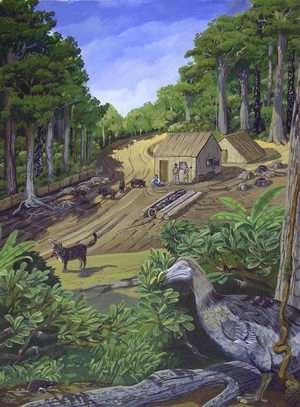Sensational new discovery of Dodo bones on Mauritius

On Friday, October 28, 2005, a Dutch-Mauritian research team discovered the very first intact layer of bones and botanical materials, including Dodo remains. The material's age is estimated at 2000 to 3000 years. This new find will allow for the first scientific research into and reconstruction of the world in which the Dodo (Raphus cucullatus) lived, before western man landed on Mauritius and wiped out the species.
The fossil material was excavated in an area of Mauritius called "Mare aux Songes", a low-lying swamp area in the dry southeastern part of the island, on land owned by MTMD. So far, approximately 80 sq. feet have been excavated and more than 700 bones have been recovered. All the bones were found in one layer, and, therefore suggest a mass grave.

The discovery yielded several Dodo bones, including remains of Dodo chicks and a very rare part of the bird's beak, only a few of which are known to exist in the entire world. In addition to the dodo remains, the find included bones of various other extinct bird species, indigenous giant tortoise species, and a baby giant tortoise, as well as a large number of seeds and remains of (partly) extinct trees and plants. The location of all bones in a single layer leads scientists to believe this is a mass grave.
Although some Dodo bones were found in the 19th century in the Mare aux Songes, the site's geology and ecology have never been researched. This type of study is necessary to reconstruct the area's landscape, wildlife, and vegetation and to determine whether the animals may have perished en masse due to a natural disaster. In addition, it will enable scientists to research how such a massive collection of bones, seeds, and wood ended up in the swamp and how it has remained so well preserved.
Since Dodo bones were discovered here in 1920, there have been no subsequent finds. Thanks to geological research, this mass grave was found. Julian Hume recently re-examined the material already found in the Mare aux Songes, and discovered some bones of Dodo chicks as well. In case of future research on this site, the research team expects to discover some more remains of Dodo chicks.
The research team consists of Dutch scientists Kenneth F. Rijsdijk (geologist, TNO), Frans P.M. Bunnik (paleobotanist, TNO), and Pieter Floore (archeologist, Hollandia), Alan Grihault (a local dodo expert), and Christian Foo Kune, manager of the "Mon Trésor et Mon Désert" (MTMD) sugar cane plantation, which owns the area where the discovery was made. Julian Hume, a British paleontologist who is also a member of the research team, was able to more closely determine the bones' age and origin.
In order to allow for an accurate, systematic study of the site, an international team is being assembled. The study will be performed by local (botanical) specialists from Mauritius in close cooperation with leading European institutes including the Nationaal Natuurhistorisch Museum Naturalis from Leiden (The Netherlands), the London Natural History Museum and TNO's Geological Survey of the Netherlands.
Source: Naturalis


















